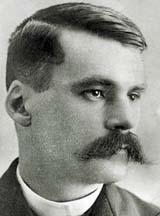
When I recently began reading one of Mom’s old books, The Trail Led North by Martha Ferguson McKeown[1], I was moved by the inscription that the author added. This hardbound copy of the 1948 edition came with these words from the author who had been a mentor to my mother for many years. In flowing penmanship, she wrote: “Jo dear, This book comes to you as a birthday gift from your mother and father. I hope you will find Uncle Mont, whom you know in person, within these pages. My love to you, Martha Ferguson McKeown.”
The book is the true life story of Martha’s Uncle Mont Hawthorne[2], a surviving Pioneer who had driven ox-teams across the prairie, built railroads, constructed and operated salmon canneries on the Columbia and in Alaska. As if that were not enough excitement, his “trail led north” where he battled harsh elements and harsher men for gold during the Yukon rush in the 1890s.
As I read the history told in Mont’s own voice, the change was striking between the human attitudes and behaviors over 50-years, from the Gold Rush era to the days of my youth—and, more so, in just another 50-years to these our present times. But one human trait has not turned up a penny’s worth of change. That is the cruel magnetic attraction that bright and shiny gold exerts on the human heart. It spoils reason. It abandons long laid plans. It darkens souls and clutters minds with envy, haste and greed.

From the text of The Trail Led North, Mont Hawthorne says:
He looked starved and he sort of shook all over while he was talking to me. He said: “We knew we could find gold. No one could tell us anything. We took the map. We drew lines. We figured out a short cut to the gold country. We wouldn’t listen to no one. But we learned. Now if a little child would try to tell us anything we would sit down and listen with tears in our eyes. We have learned to listen. Now all we ask for is to see our homes before we die.”
A friend of Mont’s who outlived him by a good spell wrote this, “For Mont Hawthorne and thousands more Klondike stampeders of another century, the Yukon River was transportation, a means to an end, a one-way ticket to the City of Gold.”[3]
Here is an excerpt from Chapter 23 of my novel Bentari. The chapter is “What Passes Down.” The passage is a glimpse into the heart of a man who was instantly and completely distracted from his firm duty by his exposure to the bright and shiny metal:
“My God in Heaven,” murmured Weltschmerz sinking to his knees and shaking visibly in front of the solid gold wall. “Here we have more gold than even the Third Reich can spend,” the trembling Weltschmerz muttered to the wall. “Here is more gold than any other mine on Earth. No man can imagine so much gold. The entire mountain rests on gold,” he babbled on from the place where his legs had buckled and he knelt stupefied before the glorious shining wall. “Who would believe it? In this forsaken jungle, so much beautiful gold! Even I don’t believe it and I am staring right at it.” He glanced over his shoulder at his lieutenant who was poring over the jewels in one of the chests.
I encourage three things here. Read The Trail Led North, a true story of one man’s life, including his bent for travel, adventure and meeting people, many of whom he helped along the way—and his attraction to gold. Read Bentari, a novel about a boy in African forests, his people and their unlikely battle against a weaponized army—in defense of gold. At last, look deeply into your heart to read your own beliefs about the meaning of wealth—its procurement, its ownership and its best purposes. Ask yourself, in what ways will humans best be served by the expenditure of our planet’s riches? Now—what do you think?
Buy Bentari now – and read about a forest full of adventure – and a treasure hunt!
Contact me by e-mail: Tim@Bentari.com – I look forward to hearing from you!
Photos: Mont Hawthorne and his niece Martha Ferguson McKeown who loved to hear him tell stories of his travels, some of which she wrote down in books
[1] https://oregonencyclopedia.org/articles/mckeown_martha_ferguson_1903_1974_/
[2] http://old.seattletimes.com/special/klondike/mont_bio.html (photo: copyright 1997 by Seattle Times Co., used here with apologies to the unknown photographer) Article errs by stating book by his daughter; it was by his niece)
[3] http://old.seattletimes.com/special/klondike/html97/river_071397.html by Ross Anderson, Mont’s friend